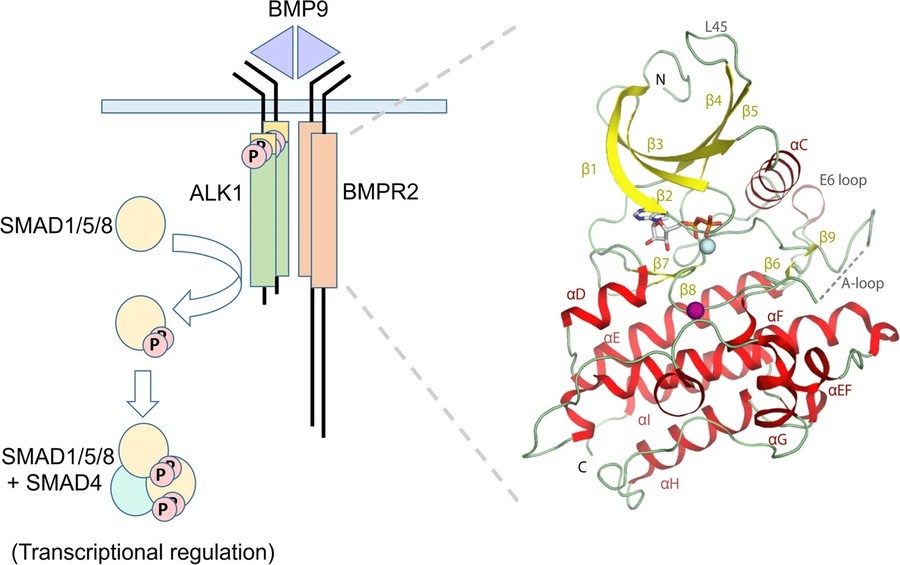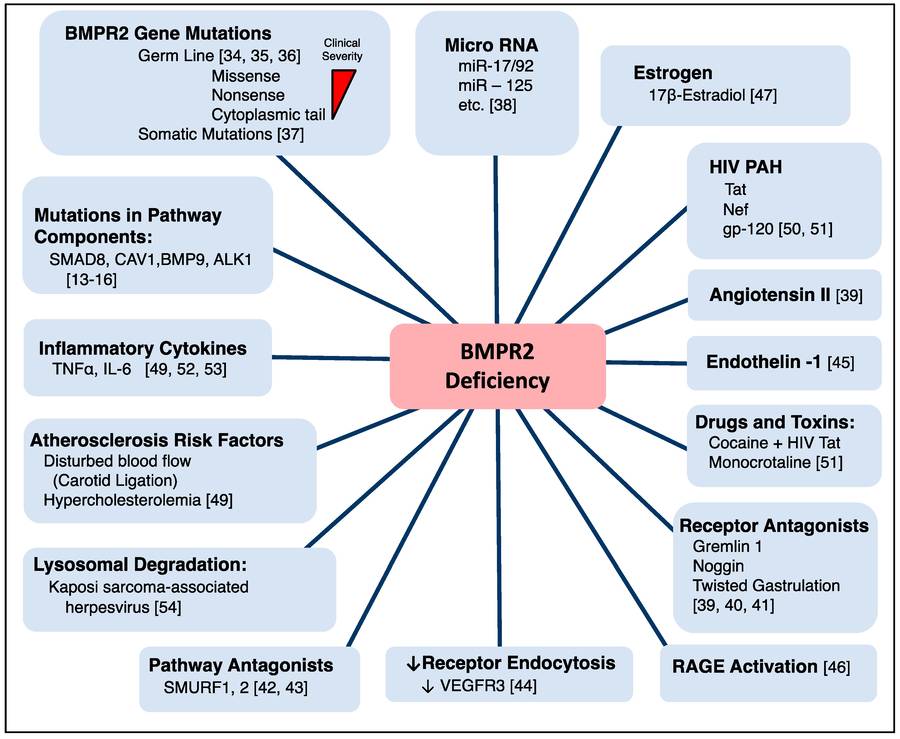| Catalog# | Product Name | Size | Price | Qty | Inquiry |
|---|---|---|---|---|---|
| THP-0030 | Dibotermin alfa; Recombinant human bone morphogenetic protein-2 (rhBMP-2) | 10ug | $298.00 |
|
Add to Cart Order |
| THP-0257 | Growth Differentiation Factor 5 (GDF-5) | 1 vial | $3,998.00 |
|
Add to Cart Order |
Bone morphogenetic protein receptor type II (BMPR2) is a transmembrane serine/threonine kinase receptor that plays a central role in the bone morphogenetic protein (BMP) signaling pathway. This pathway is part of the transforming growth factor-beta (TGF-β) superfamily and is critical for regulating cellular growth, differentiation, and homeostasis. BMPR2 acts as the type II receptor in the BMP signaling cascade and works in conjunction with type I receptors, such as BMPR1A and BMPR1B, to mediate the effects of BMP ligands. Dysregulation of BMPR2 signaling has been implicated in several pathological conditions, including pulmonary arterial hypertension (PAH), cancer, fibrosis, and cardiovascular diseases. This makes BMPR2 an attractive therapeutic target for drug development.
NCBI Gene ID: 659
UniProtKB ID: Q13873
BMPR2 is a large protein comprising three major domains:
In the canonical BMP signaling pathway, BMP ligands bind to BMPR2 and recruit type I receptors. Active BMPR2 phosphorylates the type I receptor, which then phosphorylates receptor-regulated Smads (R-Smads), such as Smad1, Smad5, and Smad8. These phosphorylated Smads form a complex with Smad4, which translocates to the nucleus to regulate target gene expression. In addition to the canonical Smad-dependent pathway, BMPR2 also activates non-Smad signaling pathways, including the p38 MAPK, PI3K/Akt, and Rho GTPase pathways, allowing for a broader range of cellular responses.
 Figure 1. Structural overview of the BMPR2
complex. Schematic of the canonical BMPR2 signaling complex implicated in PAH and related vascular disorders (left) and crystal structure of the recombinant
BMPR2 kinase domain (right). Secreted dimeric ligands such as BMP9 assemble a heteromeric transmembrane receptor complex consisting of two type I receptors
(ALK1 shown) and two type II receptors (BMPR2 shown). Ligand binding stimulates BMPR2-mediated phosphorylation of the GS domain in ALK1, which activates
ALK1 for the subsequent recruitment and phosphorylation of SMAD1/5/8 proteins. Two of these phosphorylated SMADs then assemble with SMAD4 as a heterotrimer
for nuclear translocation where they bind to promoter regions containing SMAD-binding elements for transcriptional regulation. In the BMPR2 crystal
structure the secondary structure elements are labelled and shown as ribbons. ADP is shown in stick representation, and Mg2+ ion (cyan) and
sulphate molecule (purple) are displayed as spheres. Disordered residues in the activation loop (A-loop) are indicated by a dotted line. (Chaikuad
et al., 2019)
Figure 1. Structural overview of the BMPR2
complex. Schematic of the canonical BMPR2 signaling complex implicated in PAH and related vascular disorders (left) and crystal structure of the recombinant
BMPR2 kinase domain (right). Secreted dimeric ligands such as BMP9 assemble a heteromeric transmembrane receptor complex consisting of two type I receptors
(ALK1 shown) and two type II receptors (BMPR2 shown). Ligand binding stimulates BMPR2-mediated phosphorylation of the GS domain in ALK1, which activates
ALK1 for the subsequent recruitment and phosphorylation of SMAD1/5/8 proteins. Two of these phosphorylated SMADs then assemble with SMAD4 as a heterotrimer
for nuclear translocation where they bind to promoter regions containing SMAD-binding elements for transcriptional regulation. In the BMPR2 crystal
structure the secondary structure elements are labelled and shown as ribbons. ADP is shown in stick representation, and Mg2+ ion (cyan) and
sulphate molecule (purple) are displayed as spheres. Disordered residues in the activation loop (A-loop) are indicated by a dotted line. (Chaikuad
et al., 2019)
BMPR2 plays a critical role in regulating vascular homeostasis, cell proliferation, and apoptosis. Dysregulation of BMPR2 signaling is associated with several diseases, highlighting its potential as a therapeutic target.
 Figure 2. Mechanisms for BMPR2 deficiency. ALK:
activin-like receptor; BMP: bone morphogenetic protein; BMPR2: bone morphogenetic protein receptor 2; CAV1: caveolin 1; gp-120: envelope glycoprotein GP120;
HIV: human immunodeficiency virus; Nef: negative factor; RAGE: receptor for advanced glycation end products; SMAD: mothers against decapentaplegic; SMURF:
SMAD-specific E3 ubiquitin protein ligase; Tat: trans-activator of transcription; VEGFR3: Vascular endothelial growth factor receptor 3. (Andruska and
Spiekerkoetter, 2018)
Figure 2. Mechanisms for BMPR2 deficiency. ALK:
activin-like receptor; BMP: bone morphogenetic protein; BMPR2: bone morphogenetic protein receptor 2; CAV1: caveolin 1; gp-120: envelope glycoprotein GP120;
HIV: human immunodeficiency virus; Nef: negative factor; RAGE: receptor for advanced glycation end products; SMAD: mothers against decapentaplegic; SMURF:
SMAD-specific E3 ubiquitin protein ligase; Tat: trans-activator of transcription; VEGFR3: Vascular endothelial growth factor receptor 3. (Andruska and
Spiekerkoetter, 2018)
Therapeutic proteins targeting BMPR2 play a critical role in modulating bone growth, vascular function and lung health. BMPR2 is a key receptor in the transforming growth factor-beta (TGF-β) superfamily and is involved in the regulation of cell growth, differentiation and apoptosis. Dysregulation of BMPR2 signaling has been implicated in diseases such as PAH, bone disorders and certain cancers.
| Therapeutic Proteins | Mechanism | Applications |
|---|---|---|
| BMP-9 and BMP-10 | These naturally occurring ligands of BMPR-II regulate vascular homeostasis and bone metabolism by activating downstream SMAD signaling pathways. | Investigated for potential use in the treatment of PAH, osteoporosis, and vascular disorders. |
| Recombinant BMP-2 and BMP-7 | While primarily targeting BMPR-IA and BMPR-IB, these proteins also interact with BMPR-II to support bone regeneration and cartilage repair. | Used in spinal fusion, fracture healing and osteoarthritis treatment. |
| BMPR-II-Fc Fusion Proteins | These engineered fusion proteins act as BMPR-II ligand traps, binding excess BMP ligands to modulate abnormal signaling. | Under investigation for PAH therapy, as BMPR-II mutations are a major cause of the disease. |
| Soluble BMPR-II (sBMPR-II) | A recombinant form of the extracellular domain of BMPR-II that neutralizes excessive BMP signaling, restoring balance in vascular and bone diseases. | Potential therapeutic candidate for PAH and fibrosis-related disorders. |
Need therapeutic proteins for BMPR2 target? Contact us today, Creative BioMart is your trusted partner.
References
For more information on how our products could help advance your project, please contact us.
ENTER YOUR EMAIL HERE TO SUBSCRIBE.
Copyright © 2025 Creative BioMart. All Rights Reserved.